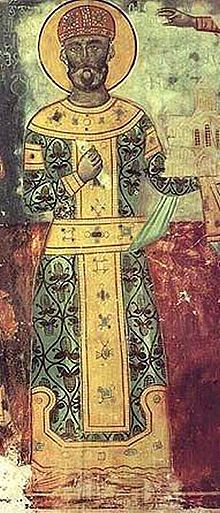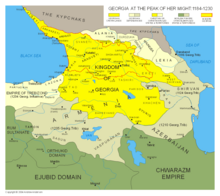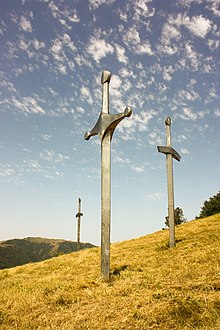Battle of Didgori
| Battle of Didgori | |||||||
|---|---|---|---|---|---|---|---|
| Part of Georgian-Seljuk wars | |||||||
 Monument at the Didgori field, Georgia | |||||||
| |||||||
| Belligerents | |||||||
| Great Seljuq Empire |
| ||||||
| Commanders and leaders | |||||||
| Ilghazi | David IV | ||||||
| Strength | |||||||
| 400,000-600,000 (various Muslim, Christian chronicles). 100,000-250,000 according to modern Georgian estimates.[1][2] | 55,600 | ||||||
| Casualties and losses | |||||||
| About 70% Of Seljuks were killed, 25% captured [citation needed] | Very minor losses as various medieval chronicles[dubious – discuss] | ||||||
The Battle of Didgori (Georgian: დიდგორის ბრძოლა) was fought between the armies of the Kingdom of Georgia and the declining Great Seljuq Empire at the place of Didgori, 40 km west of Tbilisi, (the modern-day capital of Georgia), on August 12, 1121. The battle resulted in King David IV of Georgia’s decisive victory over a Seljuk invasion army under Ilghazi and the subsequent reconquest of a Muslim-held Tbilisi, which became the royal capital. The victory at Didgori inaugurated the medieval Georgian Golden Age and is celebrated in the Georgian chronicles as a "miraculous victory" (ძლევაჲ საკვირველი, dzlevay sakvirveli). Modern Georgians continue to remember the event as an annual September festival known as Didgoroba ("[the day] of Didgori").[3]
Background

The Kingdom of Georgia had been a tributary to the Great Seljuq Empire since the 1080s. However, in the 1090s, the energetic Georgian king David IV was able to exploit internal unrest in the Seljuq state and the success of the Western European First Crusade against Muslim control of the Holy Land, and established a relatively strong monarchy, reorganizing his army and recruiting Kipchak, Alan, and even "Frankish" mercenaries to lead them to the reconquest of lost lands and the expulsion of Turkish raiders. David renounced the tribute to the Seljuqs in 1096/7, put an end to the seasonal migrations of the Turks into Georgia, and recovered several key fortresses in a series of campaigns from 1103 to 1118. His major goal being the reconquest of Tbilisi, an ancient Georgian city which had been under Muslim rule for over four centuries, David launched his military activities outside Georgia, penetrating as far as the Araxes river basin and the Caspian littoral, and terrorizing Muslim traders throughout the South Caucasus. By June 1121, Tbilisi had actually been under a Georgian siege, with its Muslim élite being forced into paying a heavy tribute to David IV.[4]
The battle
The resurgence of Georgians’ military energies brought about a coordinated Muslim response. Both Georgian and Islamic sources testify that, on the complaints of the Muslims of Tbilisi, Sultan Mahmud II b. Muhammad (r. 1118-1131) sent an expedition into Georgia in which the Artuqid Ilghazi of Mardin, the Mazyadid Dubays II b. Sadaqa of Al Hillah and the sultan’s brother Tughrul, lord of Arran and Nakhichevan, with his atabeg Kun-toghdi all took part. This combined army under the overall command of Ilghazi entered the valley of Trialeti in eastern Georgia and encamped in the vicinities of Didgori and Manglisi in mid-August 1121.[4]


The number of combatants as well as the course of the battle is differently related in the contemporaneous historical records. King David’s army has traditionally been estimated at 40,000 Georgians, 15,000 Kipchaks, 500 Alans and 100 "Frankish" Crusaders. The number of Frankish crusaders remains undisputed. According to the Arab chronicler Ibn al-Athir, David sent a small detachment of his men in order to simulate negotiation. Meanwhile, he successfully managed to deploy a large portion of his troops where they would almost encircle the enemy in a pincer movement. The Seljuq leadership remained unaware of such activities. Upon approaching the Seljuq leaders, the diplomat group unveiled their real intentions by suddenly attacking and killing the enemy commander and others who were attending. This decisive surprise attack caused confusion in the ranks of the Seljuq forces and likely contributed to the chaotic response to the final attack. The Georgian forces were divided into several groups under David and his son, Demetrius. Those simultaneously struck against the Seljuq flanks, leaving only a gap in the rear so that an escape was possible. David considered that as a calculated part of his plan. Seeing that gap, the psychological impact of being almost completely surrounded, would provoke the leaderless men to break their formations and head to safety through the gap. However, in a pitched three hours battle, the Seljuq troops broke and were completely overrun. Many of those who fled were constantly run down by pursuing Georgian cavalry for several days. A huge amount of booty and prisoners were secured by David's army.[5] Aside from those accounts, it has also been suggested that confronted by a much smaller but still superior force, David had to rely on the advantages the nearby terrain had offered. The Seljuk cavalry was tricked into a narrow pass where they likely had not much room to maneuver and were easily taken out by spears and pikes. The rest of the coalition army was probably forced to climb slopes to attack the Georgian army's main body, while suddenly being struck at the flanks. After a while, those tactics broke the fighting will of the Muslim army, which was soon routed. King David didn't hesitate and ordered his light cavalry to run down the retreating soldiers. The amount of men fleeing the field must have been so huge, that the Georgian cavalry was on pursuit for several days. A huge number of prisoners were most likely taken. In either case, the enemy army was completely disintegrated, as the Georgians were able to liberate the entire region from Muslim influence and even contest territories within the Seljuq Empire.
Capture of Tbilisi
Following the victory, David moved relentlessly against the remaining pockets of Muslim resistance and next year, in 1122, he stormed Tbilisi, so that the city might become, according to a Georgian chronicler, "for ever an arsenal and capital for his sons." The medieval sources emphasize David’s acts of revenge against the Muslims of Tbilisi. However, the Arab historian al-'Ayni (1360–1451), who utilizes sources, some of which have not survived, admits that the city was pillaged but says that the Georgian king eventually showed patience and "respected the feelings of the Muslims more than Muslim rulers had done."[4][5]
Notes and references
- ^ Alexander Mikaberidze, Miraculous Victory:’ Battle of Didgori, 1121, Published: May 14, 2008;"The size of the Muslim army is still a matter of debate with numbers ranging from a fantastic 800,000 men (“Bella Antiochena”, Galterii Cancelarii), 600,000 Turks (Matthew of Edessa) to 400,000 (Smbat Sparapet’s Chronicle) while the estimates of modern Georgian historians vary between 100,000-250,000 men." [1]
- ^ http://books.google.de/books?id=AOyJtA0dYVUC&pg=PA47&lpg=PA47&dq=Ibn+al-Athir+Didgori&source=bl&ots=ElWeESBpvb&sig=WhCERs9P0F_V0ec8qP1TuPQQ1oA&hl=de&sa=X&ei=2GdfT6nMBMzDtAbS89y_Bg&ved=0CEYQ6AEwBA#v=onepage&q=Ibn%20al-Athir%20Didgori&f=false
- ^ Suny, Ronald Grigor (1994), The Making of the Georgian Nation, p. 36. Indiana University Press, ISBN 0-253-20915-3
- ^ a b c Minorsky, Vladimir, "Tiflis", in: M. Th. Houtsma, E. van Donzel (1993), E. J. Brill's First Encyclopaedia of Islam, 1913-1936, p. 755. Brill, ISBN 90-04-08265-4.
- ^ a b Template:Ka icon Javakhishvili, Ivane (1982), k'art'veli eris istoria (The History of the Georgian Nation), vol. 2, pp. 184-187. Tbilisi State University Press.
Further reading
Alexander Mikaberidze, "‘Miraculous Victory:’ Battle of Didgori, 1121," Armchair General (May 14, 2008) [2]
Template:De icon Fähnrich, Heinz (1994). "Die Schlacht am Didgori". Georgica 17, 33-39.
